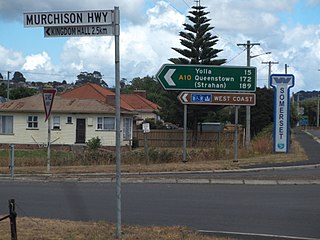
Dübs & Co. was a locomotive manufacturer in Glasgow, Scotland, founded by Henry Dübs in 1863 and based at the Queens Park Works in Polmadie. In 1903 it amalgamated with two other Glasgow locomotive manufacturers to create the North British Locomotive Company.

West Coast Council is a local government body in Tasmania, covering much of the western region of the state. West Coast is classified as a rural local government area and has a population of 4,167. The major towns and localities of the region include Strahan, Rosebery, Zeehan and the principal town of Queenstown.
Rosebery is a town on the west coast of Tasmania, Australia. It is at the northern end of the West Coast Range, in the shadow of Mount Black and adjacent to the Pieman River now Lake Pieman.

Zeehan is a town on the west coast of Tasmania, Australia 139 kilometres (86 mi) south-west of Burnie. It is part of the West Coast Council, along with the seaport Strahan and neighbouring mining towns of Rosebery and Queenstown.

The Murchison Highway is a highway located in the West Coast region of Tasmania, Australia. The 147-kilometre (91 mi) highway runs generally north–south, with Somerset, near Burnie, as its northern terminus and Zeehan as its southern terminus. The highway was opened on 13 December 1963. Part of the highway from Waratah to Burnie was known as the Waratah Highway until 1973.

The Melba Line is a 1,067 mm narrow-gauge railway on the West Coast of Tasmania. The line was originally constructed as a private railway line named the Emu Bay Railway and was one of the longest-lasting and most successful private railway companies in Australia. While at present the line travels from Burnie to Melba Flats, it previously ran through to Zeehan carrying minerals and passengers as an essential service for the West Coast community.

The North East Dundas Tramway was a 2 ft narrow gauge tramway, that ran between Zeehan and Deep Lead on the West Coast of Tasmania. Opening in 1896 and closing in 1932, it was part of the Tasmanian Government Railways network. The world's first Garratt locomotives, the K class, were used on the line.
The history of the railways on the West Coast of Tasmania has fascinated enthusiasts from around the world, because of the combination of the harsh terrain in which the railways were created, and the unique nature of most of the lines.

The Tasmanian Government Railways (TGR) was the former operator of the mainline railways in Tasmania, Australia. Formed in 1872, the railway company was managed by the Government of Tasmania, and existed until absorption into the Australian National Railways Commission in 1978.

Australian Transport Network (ATN) was a freight railway operator in Australia that commenced operating in November 1997. The company operated narrow gauge trains in Tasmania and standard gauge trains in New South Wales and Victoria. It was formed as a joint venture with Tranz Rail owning 67% and Wisconsin Central 33%. In February 2004, ATN was sold to Pacific National.

Rail transport in Tasmania consists of a network of narrow gauge track of 1,067 mm reaching virtually all cities and major towns in the island state of Tasmania, Australia. Today, rail services are focused primarily on bulk freight, with no commercial passenger services being operated. The mainline railways of Tasmania are currently operated by TasRail, a Government of Tasmania-owned Corporation, who owns and maintains both rolling stock, locomotives, and track infrastructure.

The Wee Georgie Wood Railway is a 2 ft narrow gauge tourist tramway running from Tullah, on a 1.9 km (1.2 mi) short track by the edge of Lake Rosebery in the West Coast Municipality of Tasmania.
Tullah is a town in the northern part of the West Coast Range, on the west coast of Tasmania, about 111 km south of Burnie. The town has a population of approximately 202 people.
Melba Flats is a railway siding on the Emu Bay Railway east of Zeehan that served as a terminus for trains carrying copper ore from the Mount Lyell Mining and Railway Company in west coast Tasmania, once the Emu Bay Railway ceased services into the Zeehan townsite.

Zeehan railway station in Tasmania, was a major junction and railway yard for numerous different railway and tramway systems in western Tasmania in the town of Zeehan.

AN Tasrail was an Australian railway operator that operated the Tasmanian rail network from March 1978 until November 2004. Originally a subsidiary of the Federal Government's Australian National, it was sold to Australian Transport Network (ATN) in November 1997. ATN was acquired by Pacific National in 2004 and the AN Tasrail subsidiary was later acquired by the Tasmanian Government in 2009 to become TasRail.

The DQ class were a class of diesel locomotives in New Zealand and Tasmania. Originally built by Clyde Engineering in the 1960s as Queensland Rails 1460 and 1502 class locomotives. They were purchased by Tranz Rail in 1995 to be rebuilt, as a cheaper alternative to buying new locomotives. Tranz Rail rebuilt 16 locos into the DQ class. Tranz Rail then sold the 12 DQs to AN Tasrail. Only eight out of the twelve DQs are still in service today.
The West Coaster was a passenger train operated by the Emu Bay Railway between Burnie and Rosebery from October 1960 until January 1964.














